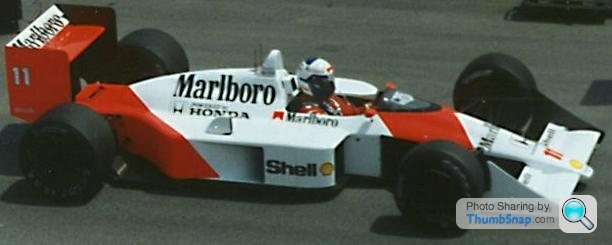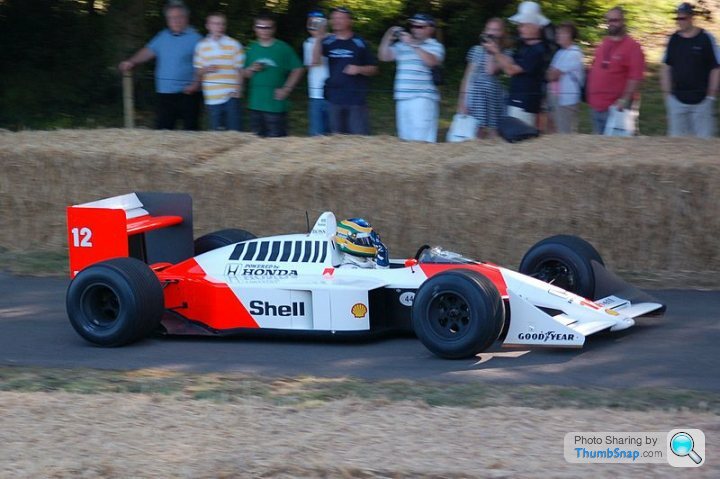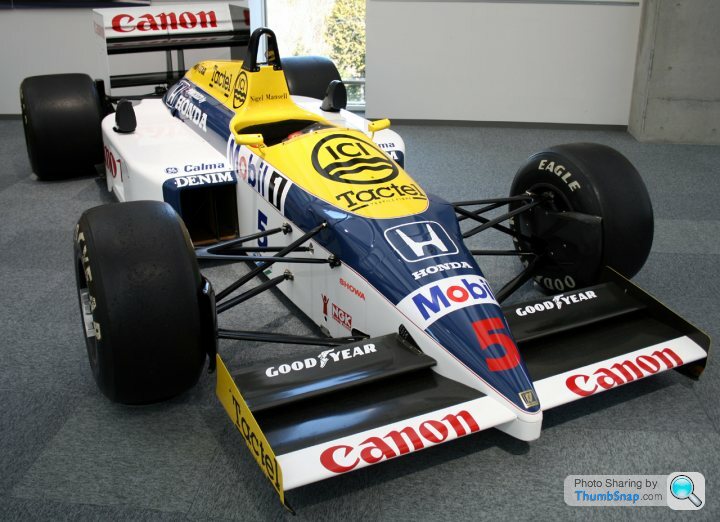1970s F1 - airboxes
Discussion
With turbocharging, the air going into the cylinder is pressurised by the turbo system. If there is a set pressure upper limit(as was the case in the later part of the old turbo era), is the ram air effect created by an airbox of no benefit because the turbo is not allowed to force air into the cylinders any higher than the regulations allow?
Therefore, is the extra aerodynamic drag of the airbox going to outweigh any increased air pressure benefits?
Why DIDN'T 1980s turbo cars have airboxes?
Do the new turbo regulations have a maximum boost limit?
Therefore, is the extra aerodynamic drag of the airbox going to outweigh any increased air pressure benefits?
Why DIDN'T 1980s turbo cars have airboxes?
Do the new turbo regulations have a maximum boost limit?
PhillipM said:
Exactly the same way as they do on an N/A car, the turbo is merely a pressure multiplier, more pressure = proportionally more pressure out. Or the ability to run a lower pressure ratio for the same amount of air into the engine.
They don't work like that, turbos are compressors that work in a defined pressure and flow range. Look up turbo compressor maps if you want to understand more.andyiley said:
I think the manufacturers may have had it in their minds that if they put the air box up in clear air there would be some measure of inlet charge pressurisation at speed and thus give a free power boost.
But that could be imagined!
not imagined. A few years ago the guys who design and build the Merc F1 engines came to do a presentation. They brought with them an engine block (weight about 90kg, beautiful piece of machining) and they showed us a CFD simulation of what happens in the air box.But that could be imagined!
Basically, they are able to set up pressure waves in the air box and they can try and time valve openings to coincide with the arrival of these waves. At certain RPM / RPM ranges they are well above volumetric efficiency of 1. 1.2 - 1.3, I forget, but they are indeed able to produce some kind of forced induction effect.
I saw an old turbo single seater car in the Henry Ford museum. The entry to the compressor is sat flush with the engine cover behind the driver. No air box, no air filter either! Just the blades.
Eric Mc said:
With turbocharging, the air going into the cylinder is pressurised by the turbo system. If there is a set pressure upper limit(as was the case in the later part of the old turbo era), is the ram air effect created by an airbox of no benefit because the turbo is not allowed to force air into the cylinders any higher than the regulations allow?
Therefore, is the extra aerodynamic drag of the airbox going to outweigh any increased air pressure benefits?
Why DIDN'T 1980s turbo cars have airboxes?
Do the new turbo regulations have a maximum boost limit?
Is the drag of the airbox going to be higher or lower than the extra power gained by the turbocharger doing less work?Therefore, is the extra aerodynamic drag of the airbox going to outweigh any increased air pressure benefits?
Why DIDN'T 1980s turbo cars have airboxes?
Do the new turbo regulations have a maximum boost limit?
Or the lower cooling requirements of the same?
The airbox really isn't that draggy as cooling and air feeding solutions go.
Bodywork regs or similar perhaps didn't make it worth the effort? Not really looked into it in detail, it might just be that the dynamics of the airboxes weren't fully understood and they thought it wouldn't help with a turbo in the way - look how many people used to, and still do, run air intakes that converge instead of diverge.
Edited by PhillipM on Thursday 10th October 15:34
It would be interesting to find out.
I am sure the airboxes of the 70s were very crude affairs and that nowadays the behaviour of airflow inside the box is far, far better understood.
But I am genuinely curious as to what it was that made the turbo cars drop the airbox. Indeed, why were they disappearing anyway from 1977 onwards even on NA cars?
I am sure the airboxes of the 70s were very crude affairs and that nowadays the behaviour of airflow inside the box is far, far better understood.
But I am genuinely curious as to what it was that made the turbo cars drop the airbox. Indeed, why were they disappearing anyway from 1977 onwards even on NA cars?
PhillipM said:
Bodywork regs or similar perhaps didn't make it worth the effort? Not really looked into it in detail, it might just be that the dynamics of the airboxes weren't fully understood and they thought it wouldn't help with a turbo in the way - look how many people used to, and still do, run air intakes that converge instead of diverge.
I remember that both the Williams FW11 (86/87) and McLaren MP4/4 ('88) both had, at some point snorkel type turbo inlets above each sidepod, which substituted inlets flush with (or inside) the sidepods. I think the Williams definitely finished its development with the snorkels, but can't remember if or how development was settled on the McLaren.Edited by PhillipM on Thursday 10th October 15:34
MP4/4:
with airboxes:

without:

FW11 11/B with:

without:

Edited by dr_gn on Thursday 10th October 15:54
Eric Mc said:
It would be interesting to find out.
I am sure the airboxes of the 70s were very crude affairs and that nowadays the behaviour of airflow inside the box is far, far better understood.
But I am genuinely curious as to what it was that made the turbo cars drop the airbox. Indeed, why were they disappearing anyway from 1977 onwards even on NA cars?
I'd assume that the turbo is limited to xbar of pressure, so irrespective of ambient air pressure it produces xbar, so why have a great big scoop on top of the car causing drag and disturbing the airflow to the rear wing?I am sure the airboxes of the 70s were very crude affairs and that nowadays the behaviour of airflow inside the box is far, far better understood.
But I am genuinely curious as to what it was that made the turbo cars drop the airbox. Indeed, why were they disappearing anyway from 1977 onwards even on NA cars?
Because you still need to feed air to the turbo, and even if it's limited to xbar of pressure on the outlet, the more pressure you feed the turbo, the less work it does, so it takes less bhp to drive it. And less cooling is required.
I'd be astonished if any team runs next year with no form of airbox/feed and just an open/exposed turbocharger inlet.
I'd be astonished if any team runs next year with no form of airbox/feed and just an open/exposed turbocharger inlet.
Edited by PhillipM on Thursday 10th October 16:47
PhillipM said:
jsf said:
They don't work like that, turbos are compressors that work in a defined pressure and flow range. Look up turbo compressor maps if you want to understand more.
I understand turbos perfectly well thanks, perhaps you ought to try that research yourself.The airflow that will matter most on these cars, will be the airflow through the intercooler core to transfer as much heat from the compressed air back into the airstream, which will make the air fed into the engine more dense and give the turbo less work to do to generate the required air flow.
Where the engines will gain massively compared to the previous generation turbo cars is from the advancements in turbine design and intercooler core efficiency, plus of course advancements in turbine core bearing assemblies. The compressor blade designs have come on massively since those days, in fact the last two years in particular have seen large gains in turbo compressor wheel design.
My own Twin scroll, CNC billet wheeled, surge port equipped ball bearing turbo is a good indication of these advancements.
Intercooler core efficiency is also massively improved, with the correct core materials you can see virtually no pressure drop across the core and charge temps very close to Ambient temperature. You wont need to carry heavy water to spray over the cores to help with charge temp control as was the case in the previous turbo era.
What you see on the top of the new Turbo F1 engines is a post turbine plenum chamber, which is used to equalise the pressure to all the cylinders in the engine from the turbo's outlet having been passed through the intercooler. The positioning of the inlet to the turbo will be determined by the regulations and the designer, this will draw from an external cold air source and will probably feature an expansion area prior to the turbo inlet port.
jsf said:
The why are you not answering the question? What Turbo's require is a dense cool air feed, you are better off slowing the air down in a pre turbine expansion filter assembly, then having the turbine draw from that cool dense source.
Which is exactly what an airbox does on a current N/A car, so what was your point?The plenum chamber post turbo is also an airbox, whilst we're at it...
Edited by PhillipM on Thursday 10th October 23:22
PhillipM said:
jsf said:
The why are you not answering the question? What Turbo's require is a dense cool air feed, you are better off slowing the air down in a pre turbine expansion filter assembly, then having the turbine draw from that cool dense source.
Which is exactly what an airbox does on a current N/A car, so what was your point?PhillipM said:
The plenum chamber post turbo is also an airbox, whilst we're at it...
It's nothing of the sort, it's a pressure chamber designed to damp out the spikes and provide equal flow to all cylinders, the pressure/flow in that chamber is a result of the pressure/flow generated by the turbocharger and the density increase achieved via the intercooler cooling the charge air. If you wish to call all the pipework in the system an airbox, then feel free to confuse everyone reading this.Edited by anonymous-user on Thursday 10th October 23:29
Yes, my earlier posts do say you want ram air, do you dispute that, or are under the common misapprehension that ram-air comes from somehow forcing through a decreasing gap? That's not how ram-air works, and it's not how a correctly designed N/A airbox works either.
As for this:
jsf said:
increasing pressure in the inlet increases pressure out of the turbo, and that increase in pressure results in better turbo performance, that's not the way you want the inlet to work or how a turbo works.
It's exactly how a turbo works, congratulations on buying an all singing and dancing one, nice of you to reel the specs off, but a complete fail on knowing how it actually works - you refer me to flow maps earlier, perhaps you want to check those and then wonder why they're all graphed against pressure ratio rather than absolute pressures.If it went on absolute pressures, compound turbocharging wouldn't work.
A plenum chamber dampens and evens flow to the cylinders so it can't be an airbox? What are you smoking? That's exactly what an airbox/plenum does with incoming airflow, regardless of whether that's from an incoming pipe or the external airflow.
Edited by PhillipM on Thursday 10th October 23:43
Eric Mc said:
Oooh - turbo-war 
Would someone please answer my question? Why were there no airboxes on the 1980s turbo cars?
See my reply earlier:
Would someone please answer my question? Why were there no airboxes on the 1980s turbo cars?
There were in may cases, but usually in the form of snorkels or periscopes. If you look at the design of some of (ie Honda), they appear to have an inlet and a divergent section leading to - dare I say - plenum over the compressor inlet.
After looking into it a bit more it seems some cars developed to have them, where others developed to remove them.
I suppose you could look on them as a form of airbox. I was thinking of the more "traditional" type i.e. above or on either side of the roll over bar.
And the fact that the snorkel type seemed to be in use by a small number of teams for a short period of time indicates that they didn't confer much of an advantage.
And the fact that the snorkel type seemed to be in use by a small number of teams for a short period of time indicates that they didn't confer much of an advantage.
Gassing Station | Formula 1 | Top of Page | What's New | My Stuff


